The Development and Use of Isoscapes to Determine the Geographical Origin of Quercus spp. in the United States
Abstract
:1. Introduction
2. Materials
3. Methods
4. Measurement:
5. Statistical Analysis
5.1. Linear Regressions—Model Building
5.2. Climatic Parameter Selection
5.3. Model Assessment
6. Results
6.1. Oxygen Isotope Ratios—18O/16O
6.2. Hydrogen Isotope Ratios—D/H
6.3. Carbon Isotope Ratios—13C/12C
6.4. Sulfur Isotope Ratios—34S/32S (or δ34S)
6.5. Assessment of the Reliability of the Models
7. Discussion
7.1. Oxygen Isotope Ratios—18O/16O
7.2. Hydrogen Isotope Ratios—D/H
7.3. Carbon Isotope Ratios—13C/12C
7.4. Sulfur Isotope Ratios—34S/32S
8. Model Assessment Using the Test Dataset
9. Conclusions
Supplementary Materials
Author Contributions
Funding
Acknowledgments
Conflicts of Interest
References
- Environmental Investigation Agency. Liqidating the Forests: Hardwood Flooring, Organized Crime, and the World’s Last Siberian Tigers; Environmental Investigation Agency: London, UK, 2013. [Google Scholar]
- U.S. Fish and Wildlife Service. Office of Law Enforcement; Lacey Act. 18 USC 42-43. 16 USC 3371-3378; U.S. Fish and Wildlife Service: Washington, DC, USA, 2008.
- Regulation (EU) No 995/2010. Guidance Document for the Eu Timber Regulation. Brussels, 12.2.2016 C(2016) 755 Final. Available online: https://disc.gsfc.nasa.gov/datasets/OMNO2d_003/summary (accessed on 30 July 2020).
- Illegal Logging Prohibition Act 2012. Compilation No. 3. Authorised Version C2018C00027 Registered 22/01/2018. Available online: https://www.legislation.gov.au/Details/C2012A00166 (accessed on 30 July 2020).
- Horacek, M.; Jakusch, M.; Krehan, H. Control of Origin of Larch Wood: Discrimination between European (Austrian) and Siberian Origin by Stable Isotope Analysis. Rapid Commun. Mass Spectrom. 2009, 23, 3688–3692. [Google Scholar] [CrossRef]
- Boner, M.; Somner, T.; Erven, C.; Forstel, H. Stable Isotopes as a Tool to Trace Back the Origin of Wood. In Proceedings of the International Workshop “Fingerprinting Methods for the Identification of Timber Origins”, Bonn, Germany, 8–9 October 200.
- Rees, G.O. Verifying the Declared Origin of Timber Using Stable Isotope Ratio and Multi-Element Analyses. Master’s Thesis, University of York, Heslington, UK, 2015. Available online: http://etheses.whiterose.ac.uk/9522/ (accessed on 23 April 2018).
- Degen, B.; Bouda, H.N.; Blanc-Jolivet, C. Completion Report of the ITTO Project PD 620/11 Rev.1 (M): Development & Implementation of a Species Identification and Timber Tracking System with DNA Fingerprints and Isotope in Africa. Available online: https://www.thuenen.de/en/fg/research-groups/ecological-genetics/completed-projects/species-identification-and-timber-tracking-system-in-africa-with-dna-fingerprints-and-stable-isotopes-in-africa/ (accessed on 30 July 2020).
- Camin, F.; Boner, M.; Bontempo, L.; Fauhl-Hassek, C.; Kelly, S.D.; Riedl, J.; Rossmann, A. Stable Isotope Techniques for Verifying the Declared Geographical Origin of Food in Legal Cases. Trends Food Sci. Technol. 2017, 61, 176–187. [Google Scholar] [CrossRef]
- Craig, H. Isotopic Variations in Meteoric Waters. Science 1961, 133, 1702–1703. [Google Scholar] [CrossRef]
- Leavitt, S.W. Tree-Ring C–H–O Isotope Variability and Sampling. Sci. Total Environ. 2010, 408, 5244–5253. [Google Scholar] [CrossRef]
- Bowen, G.J.; Revenaugh, J. Interpolating the Isotopic Composition of Modern Meteoric Precipitation. Water Resour. Res. 2003, 39. [Google Scholar] [CrossRef]
- Bowen, G.J.; Wassenaar, L.I.; Hobson, K.A. Global Application of Stable Hydrogen and Oxygen Isotopes to Wildlife Forensics. Oecologia 2005, 143, 337–348. [Google Scholar] [CrossRef] [PubMed]
- Gori, Y.; Stradiotti, A.; Camin, F. Timber isoscapes. A Case Study in a Mountain Area in the Italian Alps. PLoS ONE 2018, 13, e0192970. [Google Scholar] [CrossRef] [PubMed] [Green Version]
- Little, E.L., Jr. Atlas of United States Trees. Volume 1. Conifers and Important Hardwoods; Misc. Publ. 1146; Department of Agriculture, Forest Service: Washington, DC, USA, 1971; p. 320.
- Little, E.L., Jr. Atlas of United States Trees. Volume 3. Minor Western Hardwoods; Misc. Publ. 1314; Department of Agriculture, Forest Service: Washington, DC, USA, 1976; p. 13.
- Little, E.L., Jr. Atlas of United States Trees. Volume 4. Minor Eastern Hardwoods; Misc. Pub. No. 1342; Department of Agriculture, Forest Service: Washington, DC, USA, 1977; p. 17.
- Little, E.L., Jr. Atlas of United States Trees. Volume 5. Florida; Misc. Publ. 1361; U.S. Department of Agriculture, Forest Service: Washington, DC, USA, 1978; p. 22.
- Thompson, R.S.; Anderson, K.H.; Bartlein, P.J. Digital Representations of Tree Species Range Maps from “Atlas of United States trees”. In Atlas of Relations between Climatic Parameters and Distributions of Important Trees and Shrubs in North America; Geological Survey, Information Services: Denver, CO, USA, 1999. [Google Scholar]
- Loader, N.J.; Robertson, I.; Barker, A.C.; Switsur, V.R.; Waterhouse, J.S. An Improved Technique for the Batch Processing of Small Whole Wood Samples to Cellulose. Chem. Geol. 1997, 136, 313–317. [Google Scholar] [CrossRef]
- Brendel, O.; Iannetta, P.P.M.; Stewart, D. A Rapid and Simple Method to Isolate Pure Alpha-Cellulose. Phytochem. Anal. 2000, 11, 7–10. [Google Scholar] [CrossRef]
- Cheung, C. Studies of the Nitration of Cellulose—Application in New Membrane Materials; University of British Columbia: Vancouver, BC, Canada, 2014. [Google Scholar] [CrossRef]
- Kelly, S.; Marigheto, N.; Baxter, M.; Brereton, N.; Rose, M.; Homer, D.; Matthews, K.; Hoelzl, S.; Rummel, S.; Dekannt, D. The British Beef Origin Project (BBOP); UK Food Standards Agency: London, UK, 2007.
- DeNiro, M.J.; Epstein, S. Relationship between Oxugen Isotope Ratios of Terrestrial Plant Cellulose, Carbon Dioxide and Water. Science 1979, 204, 51–53. [Google Scholar] [CrossRef] [PubMed]
- David, J.S.; Henriques, M.O.; Kurz-Besson, C.B.; Nunes, J.; Valente, F.; Vaz, M.; Siegwolf, R.; Gazarini, L.C.; Pereira, J.S.; Chaves, M.M. Water-Use Strategies in Two Co-Occurring Mediterranean Evergreen Oaks: Surviving the Summer Drought. Tree Physiol. 2007, 27, 793–803. [Google Scholar] [CrossRef] [PubMed] [Green Version]
- Farquhar, G.D.; Ehleringer, J.R.; Hubick, K.T. Carbon Isotope Discrimination and Photosynthesis. Annu. Rev. Plant Biol. 1989, 40, 503–537. [Google Scholar] [CrossRef]
- Morecroft, M.D.; Roberts, J.M. Photosyntheis and Stomatal Conductance of Mature Canopy Oak (Quercus robur) and Sycamore (Acer Pseudoplatanus) Trees throughought the Growing Season. Func. Ecol. 1999, 13, 332–342. [Google Scholar] [CrossRef]
- Martin, B.; Bytnerowicz, A.; Thorstenson, Y.R. Effects of Air Pollutants on the Composition of Stable Carbon Isotopes, d13C, of Leaves and Wood, and on Leaf Injury. Plant Physiol. 1988, 88, 218–223. [Google Scholar] [CrossRef] [PubMed] [Green Version]
- Epstein, S.; Yapp, C.J.; Hall, J.H. The Determination of the D/H Ratio of Non-Exchangeable Hydrogen in Cellulose Extracted from Aquatic and Land Plants. Earth Planet. Sci. Lett. 1976, 30, 241–251. [Google Scholar] [CrossRef]
- Livingston, N.J.; Spittlehouse, D.L. Carbon Isotope Fractionation in Tree Ring Early and Late Wood in Relation to Intra-Growing Season Water Balance. Plant Cell Environ. 1996, 19, 768–774. [Google Scholar] [CrossRef]
- Loader, N.J.; Robertson, I.; McCarroll, D. Comparison of Stable Carbon Isotope Ratios in the Whole Wood, Cellulose and Lignin of Oak Tree-Rings. Palaeogeogr. Palaeoclim. Palaeoecol. 2003, 196, 395–407. [Google Scholar] [CrossRef]
- Seal, R.R. Sulfur Isotope Geochemistry of Sulfide Minerals. Rev. Miner. Geochem. 2006, 61, 633–677. [Google Scholar] [CrossRef]
- Sakai, H.; Casadevall, T.J.; Moore, J.G. Chemistry and Isotope Ratios of sulfur in Basalts and Volcanic Gases at Kilauea Volcano, Hawaii. Geochim. Cosmochim. Acta 1982, 46, 729–738. [Google Scholar] [CrossRef]
- Thode, H.; Monster, J.; Dunford, H. Sulphur Isotope Geochemistry. Geochim. Cosmochim. Acta 1961, 25, 159–174. [Google Scholar] [CrossRef]
- Robertson, I.; Field, E.M.; Heaton, T.H.E.; Pilcher, J.R.; Pollard, M.; Switsur, R. Isotope coherence in oak cellulose. In Problems of Stable Isotopes in Tree-Rings, Lake Sediments and Peat-Bogs as Climatic Evidence for the Holocene; Frenzel, B., Stauffer, B., Weib, M.M., Eds.; Fischer: Stuttgart, Germany; Vienna, Austria; New York, NY, USA, 1995; pp. 141–155. [Google Scholar]
- Brienen, R.J.; Zuidema, P.A. Relating Tree Growth to Rainfall in Bolivian Rain Forests: A Test for Six Species Using Tree Ring Analysis. Oecologia 2005, 146, 1–12. [Google Scholar] [CrossRef] [PubMed]
- Freyer, H.D. On the 13C Record in Tree Rings. Part II. Registration of Microenvironmental CO2 and Anomalous Pollution Effect. Tellus 1979, 31, 308–312. [Google Scholar] [CrossRef]
- Freyer, H.D.; Belacy, N. 13C/12C Records in Northern Hemispheric Trees during the Past 500 Years—Anthropogenic Impact and Climatic Superpositions. J. Geophys. Res. Space Phys. 1983, 88, 6844–6852. [Google Scholar] [CrossRef]
- Kevin, W. AURA, Science Systems and Applications, Inc./NASA Goddard Space Flight Center. Available online: https://neo.sci.gsfc.nasa.gov/view.php?datasetId=AURA_NO2_M&date=2018-01-01 (accessed on 30 July 2020).
- Krotkov, N.A. OMI/Aura NO2 Cloud-Screened Total and Tropospheric Column L3 Global Gridded 0.25 Degree x 0.25 Degree V3; Goddard Earth Sciences Data and Information Services Center (GES DISC); NASA Goddard Space Flight Center: Washington, DC, USA, 2013. [CrossRef]
- Christison, R. IV—Observations on the Annual and Monthly Growth of Wood in Deciduous and Evergreen Trees. Trans. R. Soc. Edinb. 1883, 32, 45–66. [Google Scholar] [CrossRef] [Green Version]
- Smith, B.N.; Oliver, J.; Mc Millan, C. Influence of Carbon Source, Oxygen Concentration, Light Intensity, and Temperature on13C/12C Ratios in Plant Tissues. Int. J. Plant Sci. 1976, 137, 99–104. [Google Scholar] [CrossRef]
- Fritts, H.C.; Blasing, T.J.; Hayden, B.P.; Kutzbach, J.E. Multivariate Techniques for Specifying Tree-Growth and Climate Relationships and for Reconstructing Anomalies in Paleoclimate. J. Appl. Meteorol. 1971, 10, 845–864. [Google Scholar] [CrossRef] [Green Version]
- Fuller, R.D.; Mitchell, M.J.; Krouse, H.R.; Wyskowski, B.J.; Driscoll, C.T. Stable Sulfur Isotope Ratios Ratios as a tool for interpreting Ecosystem Sulfur Dynamics. Water Air Soil Pollut. 1986, 28, 163–171. [Google Scholar]
- Mayer, B.; Fritz, P.; Prietzel, J.; Krouse, H. The Use of Stable Sulfur and Oxygen Isotope Ratios for Interpreting the Mobility of Sulfate in Aerobic Forest Soils. Appl. Geochem. 1995, 10, 161–173. [Google Scholar] [CrossRef]
- Novák, M.; Bottrell, S.H.; Fottová, D.; Buzek, F.; Groscheová, H.; Žák, K. Sulfur Isotope Signals in Forest Soils of Central Europe along an Air Pollution Gradient. Environ. Sci. Technol. 1996, 30, 3473–3476. [Google Scholar] [CrossRef]
- Mizota, C.; Sasaki, A. Sulfur Isotope Composition of Soils and Fertilizers: Differences between Northern and Southern Hemispheres. Geoderma 1996, 71, 77–93. [Google Scholar] [CrossRef]
- Krotkov, N.; Lamsal, L.N.; Celarier, E.A.; Swartz, W.H.; Marchenko, S.V.; Bucsela, E.J.; Chan, K.L.; Wenig, M.; Zara, M. The Version 3 OMI NO2 Standard Product. Atmospheric Meas. Tech. 2017, 10, 3133–3149. [Google Scholar] [CrossRef] [Green Version]
- Valanzuela, L.O.; Chesson, L.A.; O’Grady, P.S.; Cerling, T.E.; Ehleringer, J.R. Spatial Distributions of Carbon, Nitrogen and Sulfur Isitope Ratios in Hiuman Hair Across the Central United States. Rapid Commun. Mass Spectrom. 2011, 25, 861–868. [Google Scholar] [CrossRef] [PubMed]
- Kagawa, A.; Leavitt, S.W. Stable Carbon Isotopes of Tree Rings as a Tool to Pinpoint the Geographic Origin of Timber. J. Wood Sci. 2010, 56, 175–183. [Google Scholar] [CrossRef]
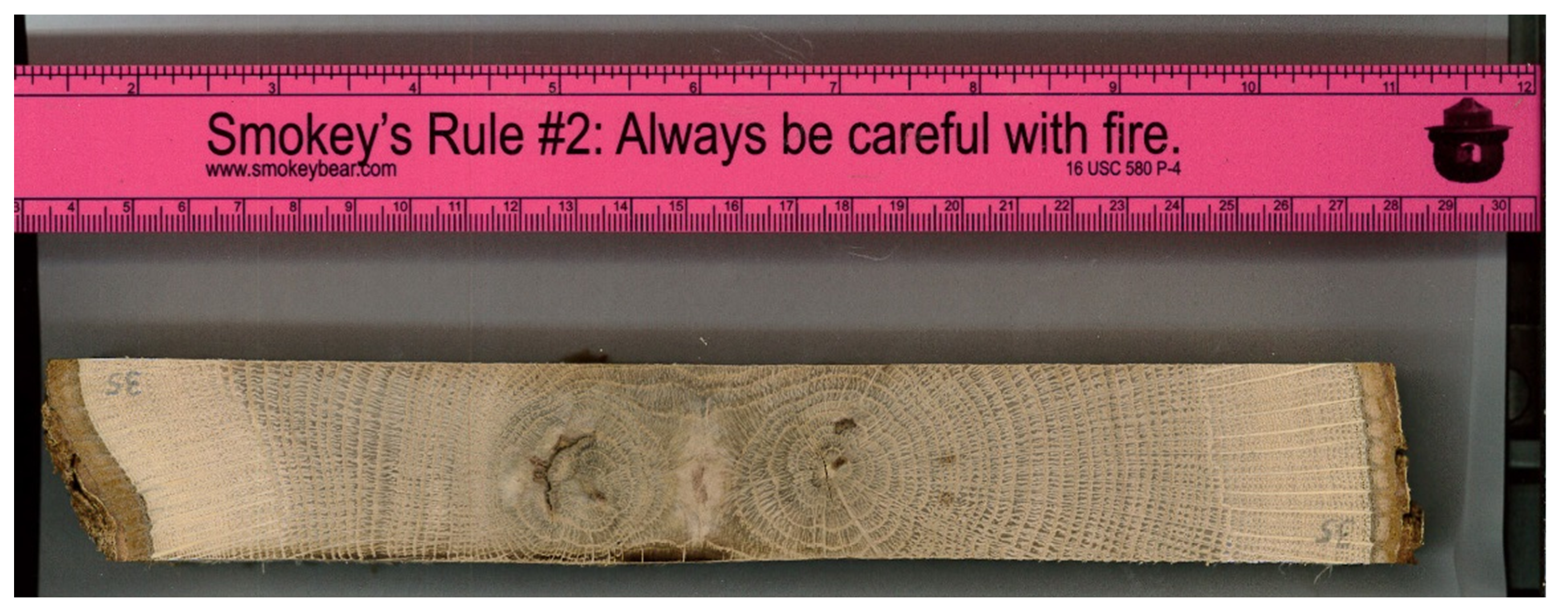
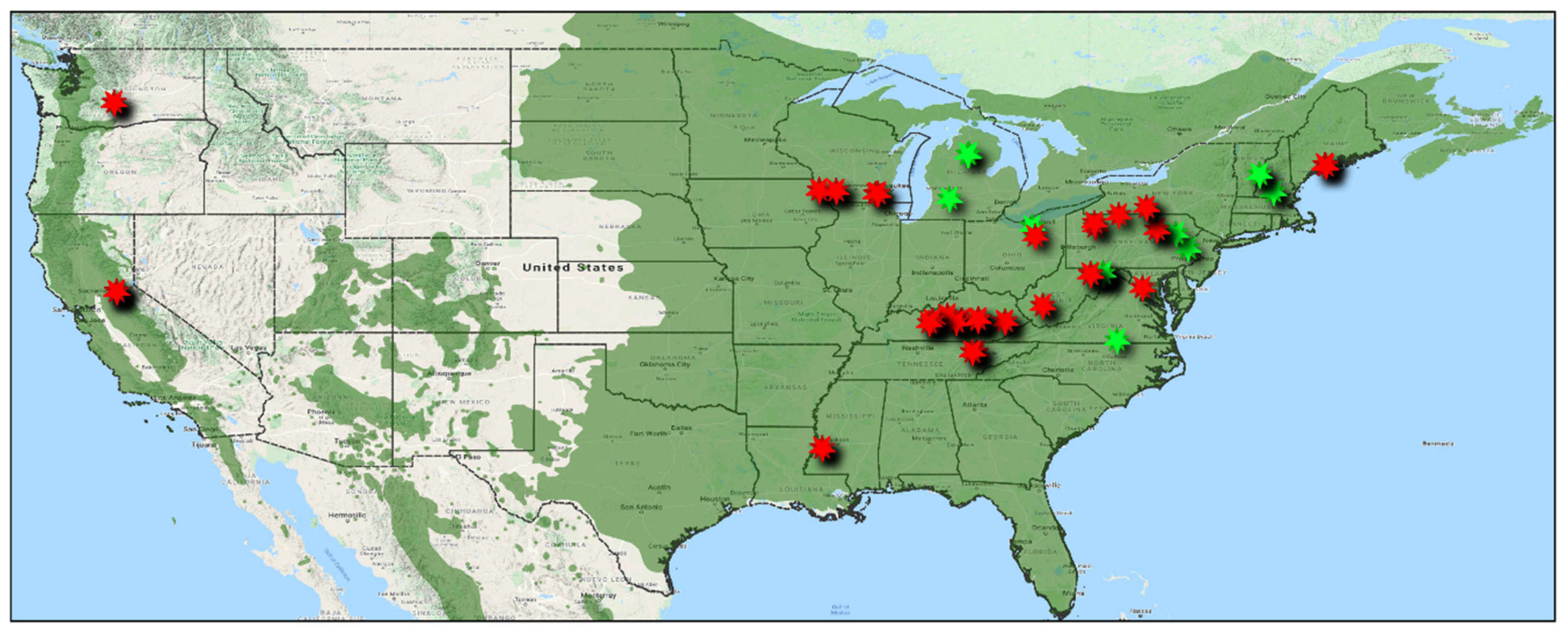
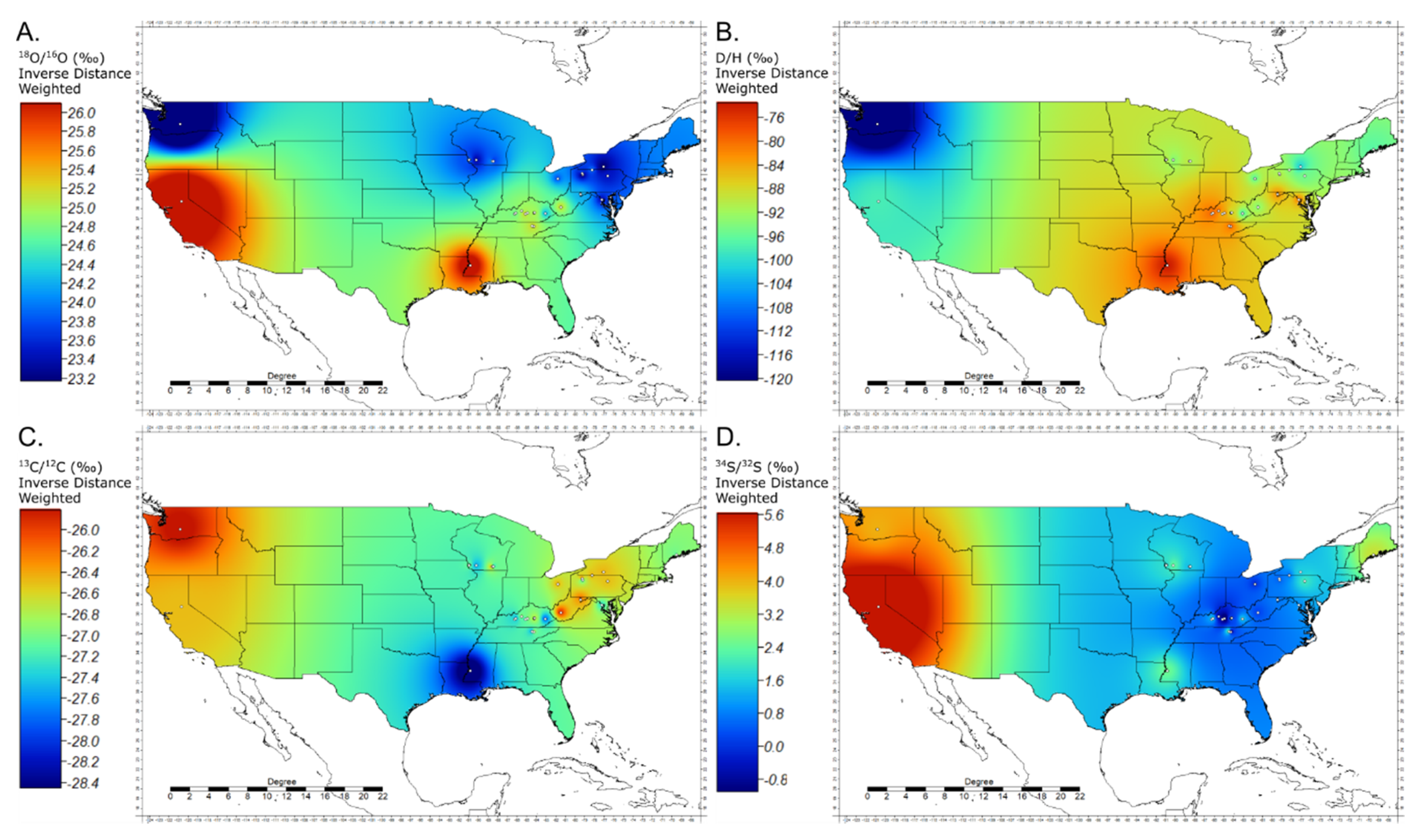
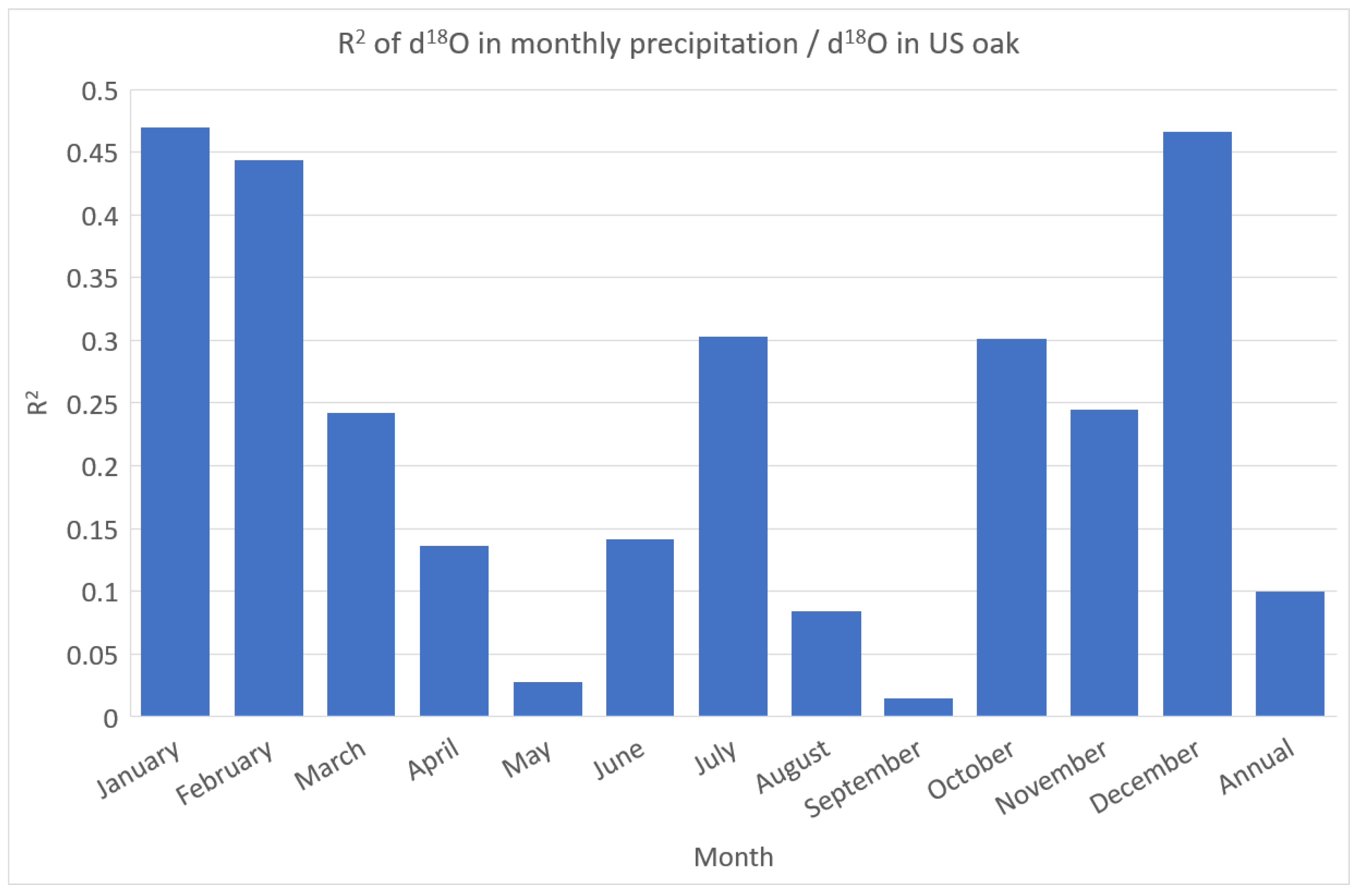
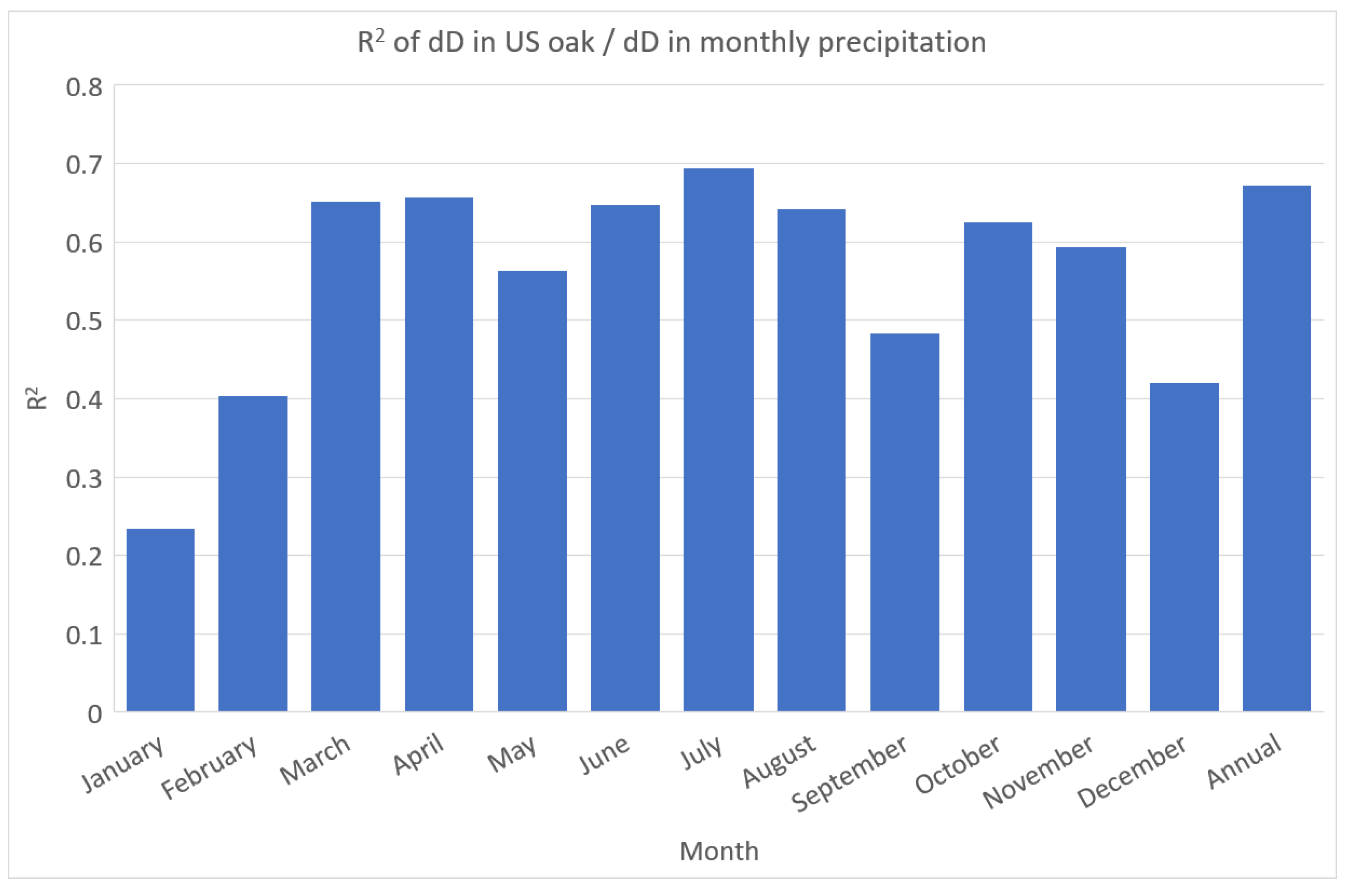
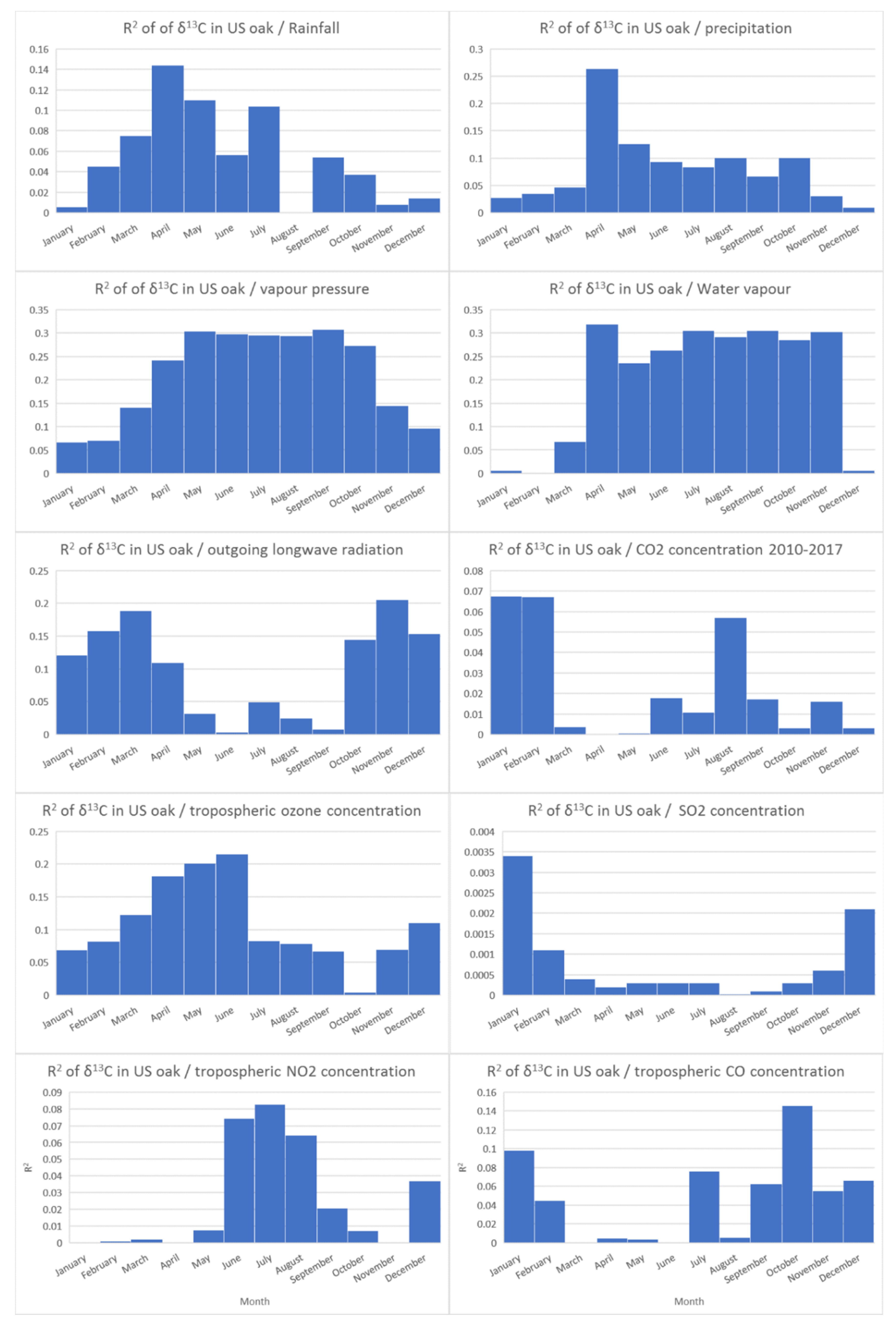
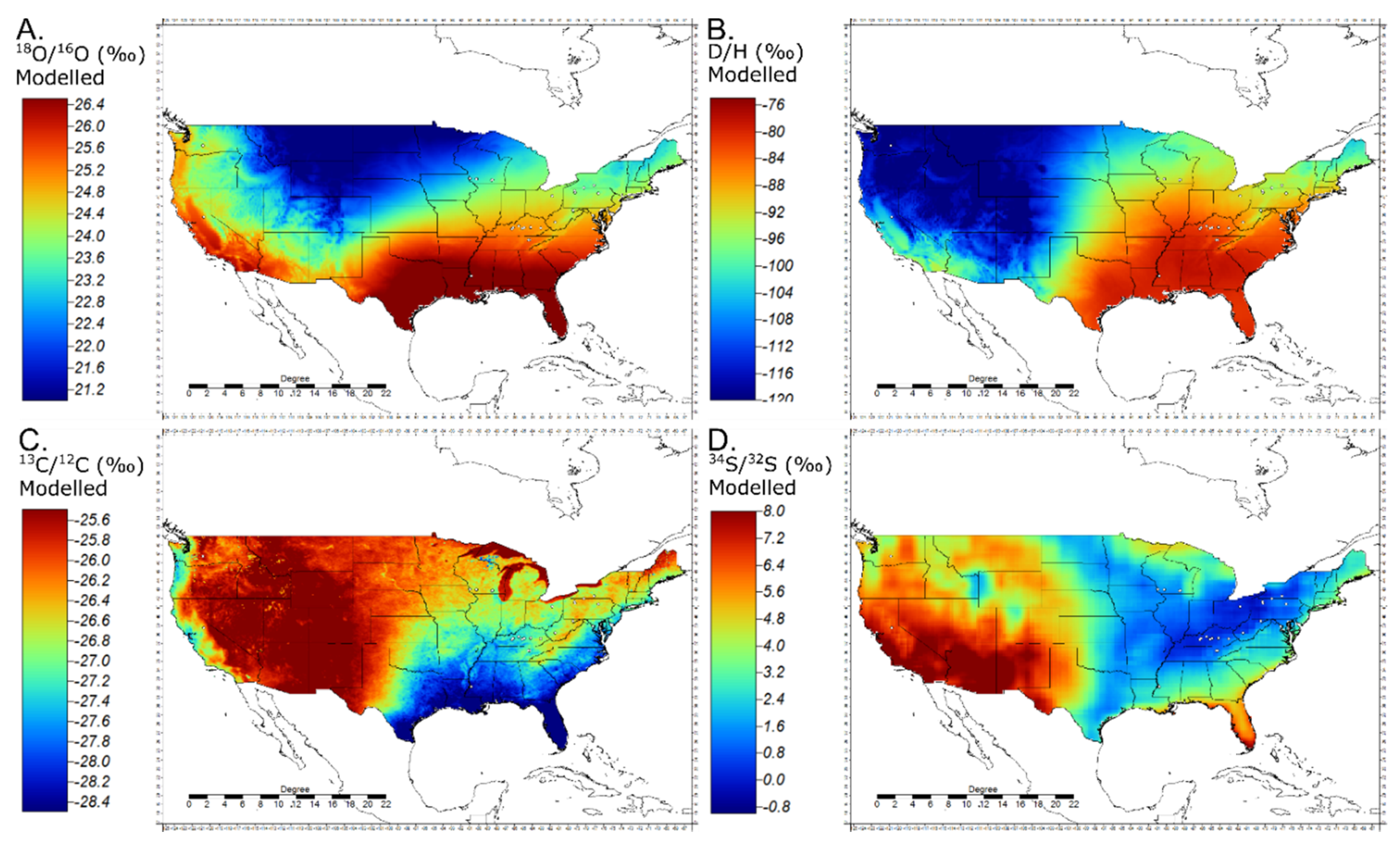
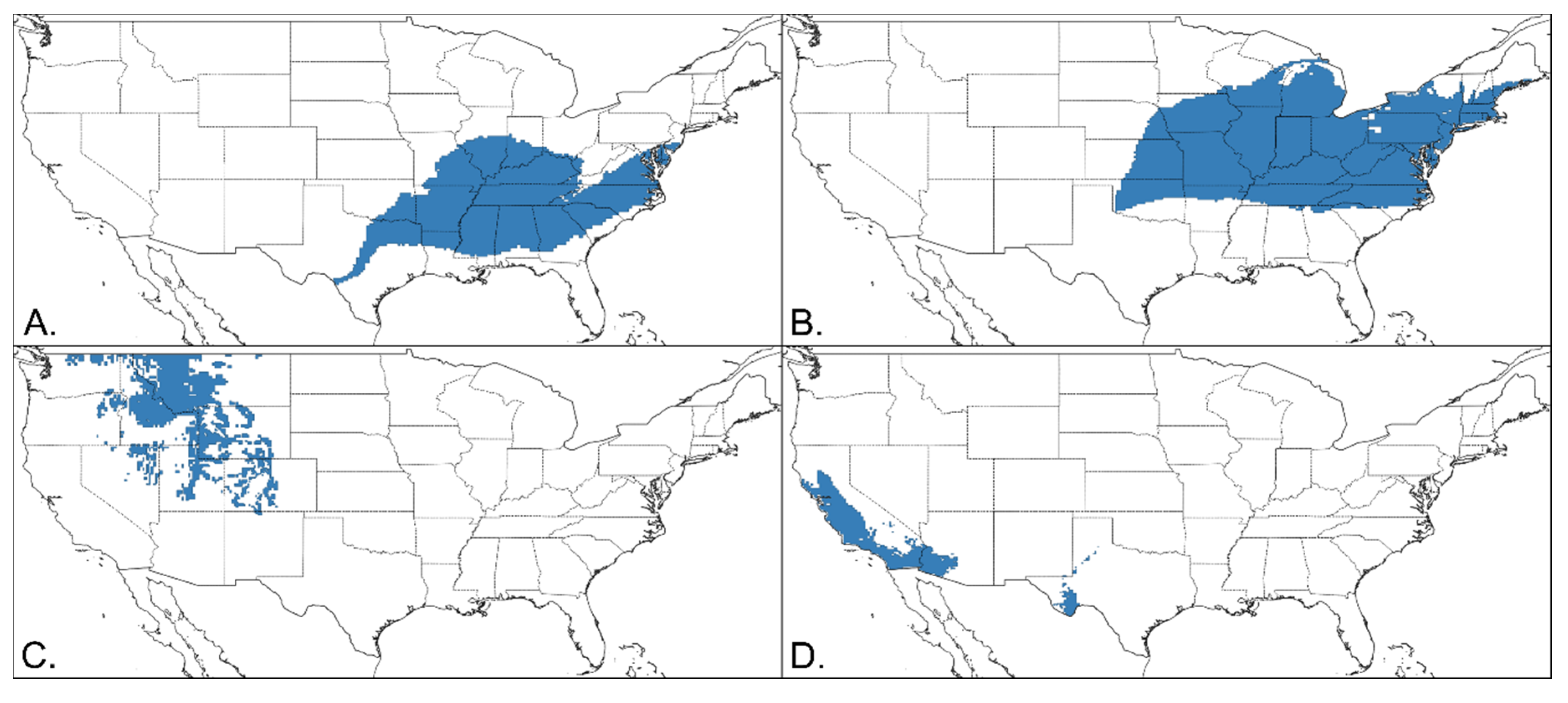
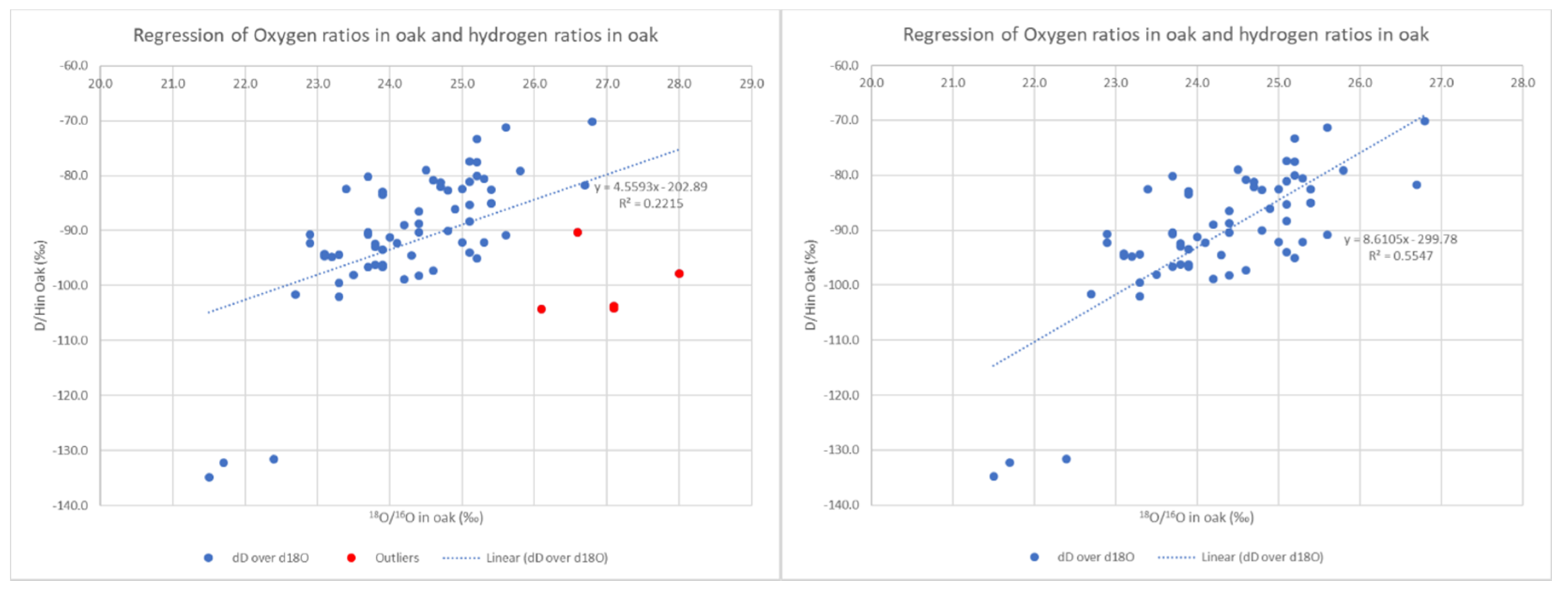
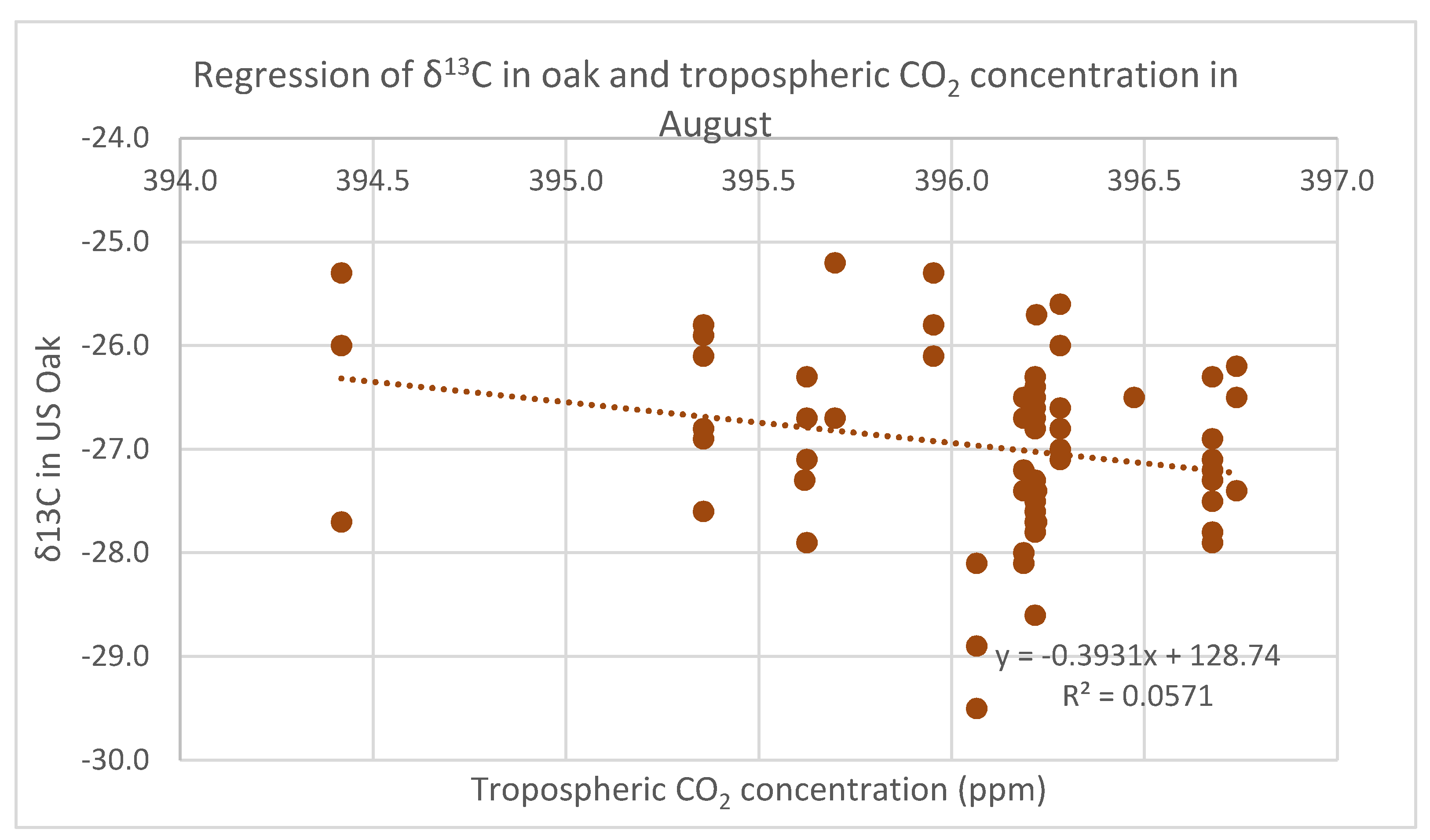
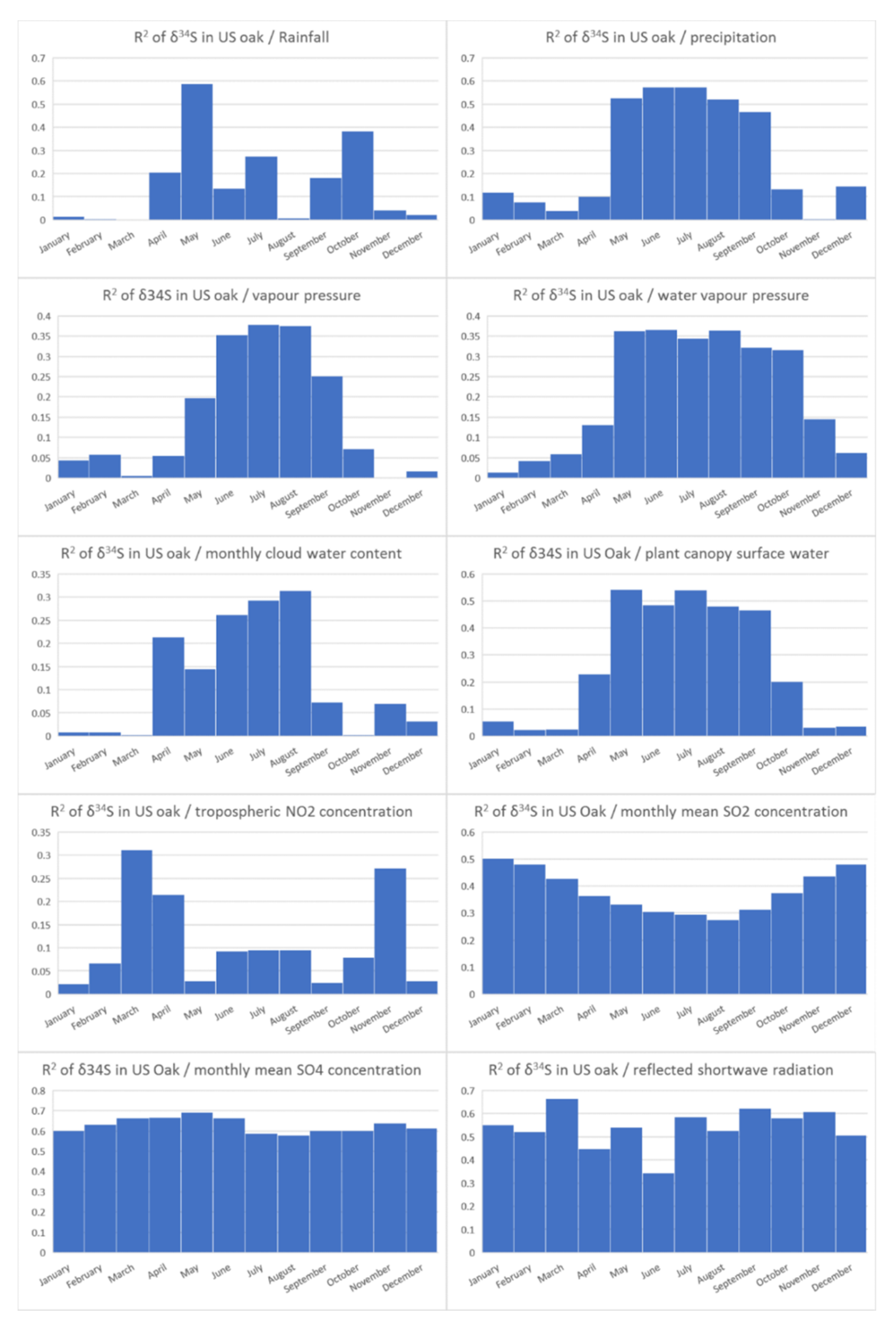
| Recorded Variety | Quantity Sampled |
|---|---|
| Chestnut oak | 2 |
| Quercus alba | 55 |
| Quercus falcata v. pagodaefolia | 1 |
| Quercus garryana | 2 |
| Quercus michauxii | 1 |
| Quercus rubra | 2 |
| Quercus rubra/garryana | 1 |
| Quercus suber | 2 |
| Red oak | 1 |
| White oak | 2 |
| State. | Quantity of Samples |
|---|---|
| California | 6 |
| Kentucky | 24 |
| Maine | 4 |
| Maryland | 3 |
| Mississippi | 3 |
| New York | 3 |
| Ohio | 1 |
| Pennsylvania | 6 |
| Tennessee | 4 |
| Virginia | 1 |
| Washington | 3 |
| West Virginia | 2 |
| Wisconsin | 9 |
| State | Quantity of Samples | 18O/16O vs. VSMOW (‰) | D/H vs. VSMOW (‰) | 13C/12C vs. PDB (‰) | 34S/32S vs. CDT (‰) | ||||||||
|---|---|---|---|---|---|---|---|---|---|---|---|---|---|
| Mean | σ | Range | Mean | σ | Range | Mean | σ | Range | Mean | σ | Range | ||
| California | 6 | 26.8 | 0.8 | 2.4 | −98.5 | 6.6 | 14.0 | −26.5 | 0.6 | 1.5 | 7.1 | 1.3 | 3.5 |
| Kentucky | 24 | 24.8 | 0.5 | 1.9 | −85.7 | 6.6 | 25.6 | −27.2 | 0.6 | 2.3 | 0.1 | 1.6 | 5.3 |
| Maine | 4 | 24.0 | 0.4 | 0.9 | −96.9 | 1.7 | 3.7 | −27.0 | 0.7 | 1.6 | 3.4 | 0.3 | 0.6 |
| Maryland | 3 | 24.2 | 0.5 | 1 | −83.8 | 4.6 | 8.8 | −26.3 | 1.2 | 2.4 | 0.7 | 0.3 | 0.5 |
| Mississippi | 3 | 26.4 | 0.7 | 1.2 | −74.4 | 6.4 | 11.6 | −28.8 | 0.7 | 1.4 | 2.4 | 0.7 | 1.2 |
| New York | 3 | 23.1 | 0.3 | 0.6 | −101.1 | 1.3 | 2.5 | −26.5 | 1.0 | 1.8 | 1.5 | 0.4 | 0.8 |
| Ohio | 1 | 23.8 | −96.3 | −26.5 | −0.1 | ||||||||
| Pennsylvania | 6 | 23.5 | 0.4 | 1 | −93.7 | 2.0 | 5.9 | −26.6 | 0.5 | 1.5 | 1.3 | 0.8 | 1.7 |
| Tennessee | 4 | 25.1 | 0.4 | 0.8 | −81.0 | 3.1 | 7.6 | −27.3 | 0.6 | 1.4 | 1.0 | 3.0 | 6.6 |
| Virginia | 1 | 23.4 | −82.5 | −27.3 | 0.9 | ||||||||
| Washington | 3 | 21.9 | 0.5 | 0.9 | −132.9 | 1.7 | 3.2 | −25.7 | 0.4 | 0.8 | 4.0 | 0.3 | 0.5 |
| West Virginia | 2 | 25.1 | 0.2 | −93.6 | 2.9 | −26.0 | 1.5 | 0.2 | 1.3 | ||||
| Wisconsin | 9 | 23.6 | 0.5 | 1.5 | −92.0 | 1.9 | 5.9 | −27.2 | 0.8 | 2.4 | 1.8 | 0.4 | 1.2 |
| Parameter | Variogram Determination (%) | Samples in Fitting Range | Lag Distance (Degrees *) | Fitting Range (Degrees *) |
|---|---|---|---|---|
| 18O/16O | 52.35 | 59 | 0.5 | 44.55 |
| D/H | 41.98 | 59 | 0.5 | 32.08 |
| 13C/12C | 2.18 | 59 | 0.5 | 44.55 |
| 34S/32S | 28.5 | 59 | 0.5 | 44.55 |
| State | Quantity of Samples | 18O/16O vs. VSMOW (‰) | D/H vs. VSMOW (‰) | 13C/12C vs. PDB (‰) | 34S/32S vs. CDT (‰) | ||||||||
|---|---|---|---|---|---|---|---|---|---|---|---|---|---|
| Mean | σ | Range | Mean | σ | Range | Mean | σ | Range | Mean | σ | Range | ||
| Maryland | 6 | 24.3 | 0.2 | 0.6 | −93.2 | 2.4 | 6.9 | −26.2 | 1.3 | 3.5 | 0.2 | 1.0 | 2.6 |
| Michigan | 3 | 23.5 | 0.7 | 1.4 | −103.5 | 9.6 | 18.4 | −26.2 | 0.8 | 1.4 | 1.0 | 1.1 | 2.2 |
| New Hampshire | 2 | 23.0 | 0 | −103.0 | 2.2 | −26.9 | 0.7 | 2.0 | 1.3 | ||||
| Ohio | 1 | 23.1 | −90.7 | −25.9 | −2.4 | ||||||||
| Pennsylvania | 2 | 24.4 | 0.5 | −92.8 | 0.4 | −26.4 | 1.1 | 2.3 | 0.9 | ||||
| Vermont | 3 | 24.3 | 0.6 | 1.1 | −100.6 | 7.9 | 13.8 | −25.1 | 0.4 | 0.7 | 2.3 | 0.2 | 0.4 |
| Virginia | 1 | 24.8 | −95.4 | −27.3 | 3.1 | ||||||||
© 2020 by the authors. Licensee MDPI, Basel, Switzerland. This article is an open access article distributed under the terms and conditions of the Creative Commons Attribution (CC BY) license (http://creativecommons.org/licenses/by/4.0/).
Share and Cite
Watkinson, C.J.; Gasson, P.; Rees, G.O.; Boner, M. The Development and Use of Isoscapes to Determine the Geographical Origin of Quercus spp. in the United States. Forests 2020, 11, 862. https://doi.org/10.3390/f11080862
Watkinson CJ, Gasson P, Rees GO, Boner M. The Development and Use of Isoscapes to Determine the Geographical Origin of Quercus spp. in the United States. Forests. 2020; 11(8):862. https://doi.org/10.3390/f11080862
Chicago/Turabian StyleWatkinson, Charles J., Peter Gasson, Gareth O. Rees, and Markus Boner. 2020. "The Development and Use of Isoscapes to Determine the Geographical Origin of Quercus spp. in the United States" Forests 11, no. 8: 862. https://doi.org/10.3390/f11080862
APA StyleWatkinson, C. J., Gasson, P., Rees, G. O., & Boner, M. (2020). The Development and Use of Isoscapes to Determine the Geographical Origin of Quercus spp. in the United States. Forests, 11(8), 862. https://doi.org/10.3390/f11080862





